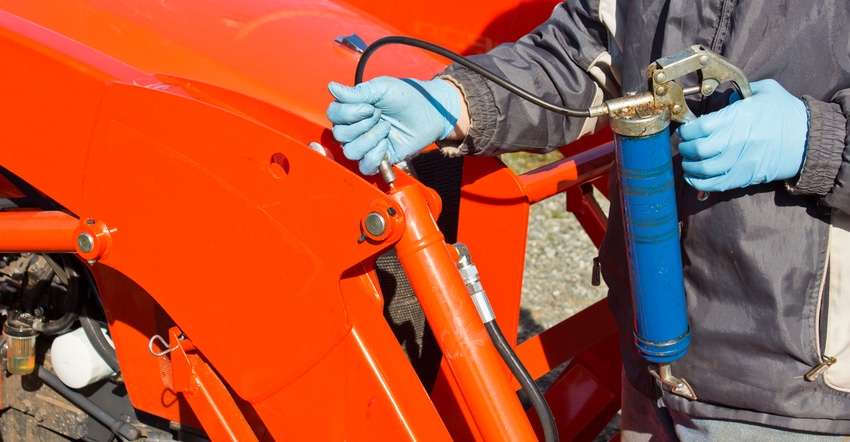December 1, 2017

When the weather outside becomes frightfully cold, many folks are singing “let it snow, let it snow, let it snow.” On our farm, we sing, “let it flow, let it flow, let it flow.” What’s flowing? Grease. With colder temperatures comes a recommendation to grease equipment.
While the goal of lubrication may be to make surfaces “slippery,” there are more advantages to greasing equipment than simply reducing friction. Lubricants can do the following:
• Improve wear and tear on equipment.
• Extend operations in extreme temperatures.
• Minimize corrosion.
With these money-saving and time-saving notions in mind, here are a few fundamental facts and suggestions on greasing equipment that can take only minutes, but save much.
Spray lubricants
For fixed or movable parts, spray lubricants work wonders to penetrate little cracks and crevices, clear out water, and even dirt, while adding oil. On the farm and even in the farm house, the aerosolized oil does wonders to lubricate intricate places. By taking a few minutes to use a spray lubricant on surfaces, this preventative measure prohibits rust and corrosion by coating the metal to protect it against the destructive nature of water and air on these surfaces.
Spray lubricants come in an aerosol can and have a variety of attachments. The straw attachment of the nozzle is popular for pointing the lubricant right where you want it. Also, hoses can be attached to the nozzle for a wider aim.
What is there to grease?
Just look around. Apply grease to friction points, such as swinging gate hinges, to allow for ease of opening in colder temperatures. Heck, I even use a spray lubricant on my boot zipper, should it get stuck. Spraying a locked-up bolt, of course, can lessen the “elbow grease” you need to turn your wrench.
For clean-up, I recommend having an old towel handy, in case your spray goes a little stray. Also, citrus-based wipes are good for reducing odor left on your hands.
Grease gun on greaser points
One of my favorite activities on the farm is getting out the grease gun. Maybe it is because of the lovely pistol grip handle that fits nicely in my hand, or maybe it is simply because I know that I am extending the life and use of equipment by giving it a blast of grease.
Grease guns come in a variety of styles, but I prefer the old-fashioned type of grease gun that manually discharges the grease. There are battery-powered grease guns that are cordless, which are speedy and do allow for more pounds per square inch of pressure. But most greasing jobs on our farm do just fine with the pistol grip for pumping the grease.
Use a grease gun to pack bearings in preparation for those colder temperatures.
Although there are ridged hoses that attach to nozzles of the grease gun, it seemingly is easier for farm equipment to have the extended flexible hose which allows maneuvering in and out of tight spots of greaser points.
Before loading a grease gun, I recommend leaving the cartridge in a warm room for a while. Grease is a fluid, and fluids are obviously affected by temperatures — the lower the temperature, the slower the flow of the grease. Warming the grease improves viscosity. Viscosity is a resistance to friction or flow, and the higher the temperature the lower the resistance. Therefore, warm up the grease and let it flow, let it flow, let it flow.
Lubricating equipment will make for more efficient usage, longer life and better reliability.
About the Author(s)
You May Also Like




